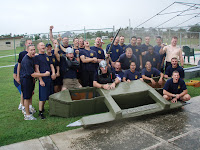

Here is a recently released investigation report that was published in Navy Times. I am haunted by the paragraph that states that he was unstrapped from his seat, but his emergency breathing device was still in his vest. I don't have much else to say about this, I need to let it sink in.
NAVY TIMES ARTICLE
Crew errors led to fatal Seahawk crash
By
Andrew Tilghman - Staff writer
Posted : Wednesday Sep 23, 2009 5:48:36 EDT
Critical crew errors during a nighttime training mission on Guam caused the crash of an MH-60S Seahawk helicopter in September 2007, according to a recently released investigation report. The crash resulted in the drowning of the helicopter’s pilot, Lt. Christian Hescock.
Hescock, 34, was practicing a low-level rope-ladder recovery operation a few feet above the water when his aircraft’s tail struck a palm tree and crashed into the water, according to the investigation.
The investigation of the Sept. 24, 2007, mishap faulted the crew members for underestimating the risk involved in the low-level terrain flight, using the wrong control system at the time of the approach and failing to wave off when the aircraft began drifting toward a tree.
It was shortly after 10 p.m. when the helo from Helicopter Sea Combat Squadron 25, based at Guam’s Andersen Air Force Base, approached the Fena Reservoir for the training mission inside Naval Ammunition Magazine Guam.
The aircraft descended over the water to about 25 feet and slowed to about 5 knots.
Problems began after one pilot instructed the other to engage the coupler, a control system that allows the crew to manually set the altitude and ground speed. But rather than engaging the coupler, the pilot instead engaged an automated control system, the report says.
Names in the investigation report provided to Navy Times were redacted, so it is unclear which pilot made the error.
That system, known as a radar altimeter hold, steadied the altitude but did not control the aircraft’s movement. The crew soon realized the helo was drifting rapidly to the right toward palm trees on a nearby spit of land.
One of the crew members saw the rotor blades approaching the trees and urgently called for power, but before the pilot could lift, the aircraft shuddered and began to yaw to the right, the report said.
The crew heard a series of loud bangs and the aircraft struck the water, left side down, nose low.
The cabin and cockpit immediately filled with water, the report says.
Using emergency breathing devices, the pilot who wasn’t Hescock and the two crew members got out of the aircraft and made it to the surface. Hescock remained trapped.
One crew member trained as a rescue swimmer tried to reach Hescock by swimming down the tail of the aircraft toward the cockpit, but he said he couldn’t see anything below the waterline because of the darkness and debris, the report says.
Emergency crews arrived shortly afterward, but divers later found Hescock’s body trapped inside the cockpit. He was unstrapped from his seat, but his emergency breathing device was still in his vest, the report says.
Doctors later determined that Hescock drowned, the report says.
The only other injury in the mishap was a broken arm, suffered by the other pilot, the report says.
The Judge Advocate General’s manual investigation was conducted by Naval Air Forces.
The investigation found that the crew’s preflight preparations incorrectly assessed the mission’s potential hazards as “low” rather than “medium.” The mission should have required a second signature from a helicopter aircraft commander.
The mishap came after a Hot Pump Crew Swap, which means the crew jumped into the aircraft immediately after a different crew had completed a training mission.
Hescock, originally from Oregon City, Ore., enlisted in the Navy in 1994, according to personnel records; he graduated from University of San Diego and received his commission in 2002.













